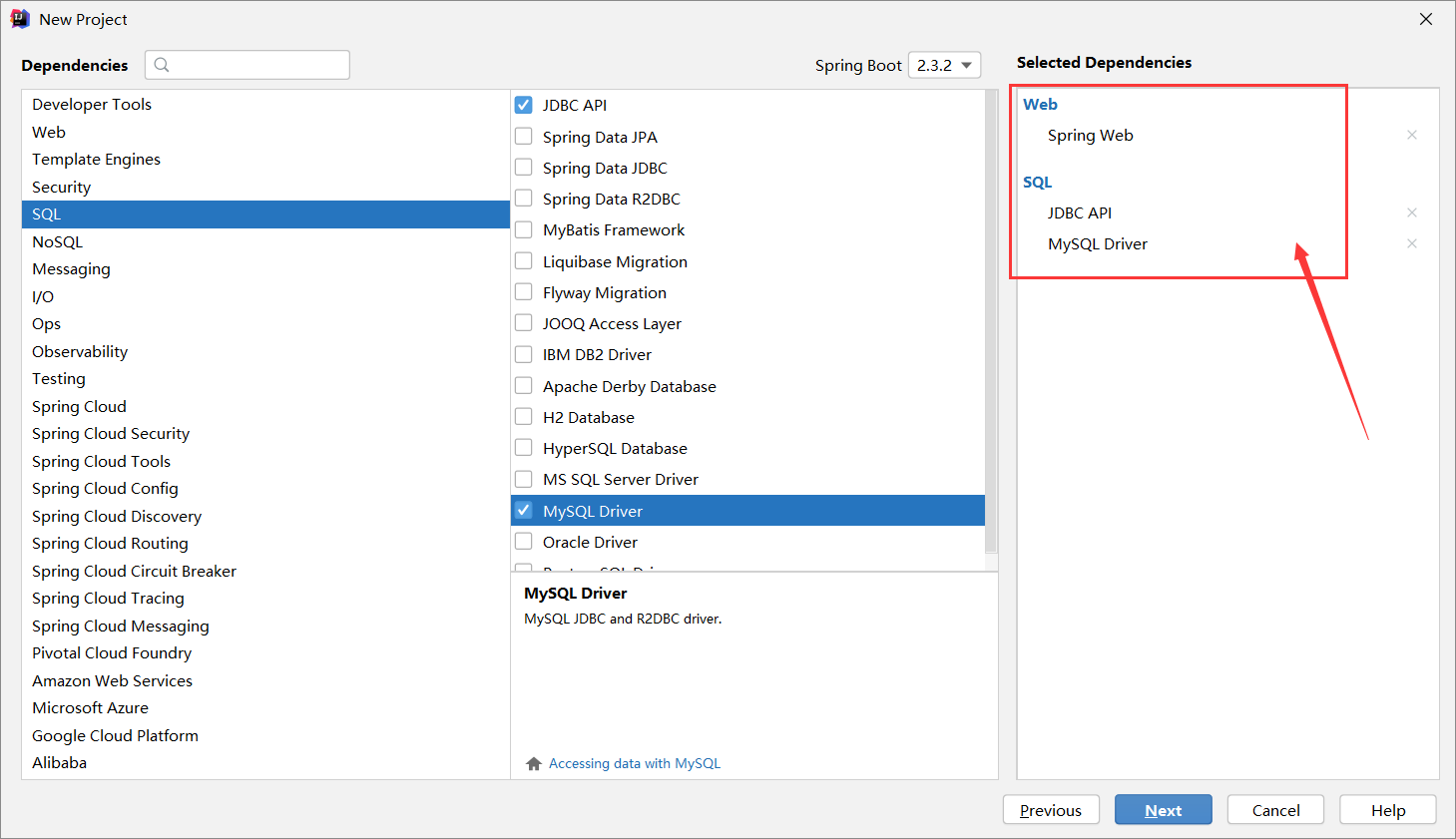SpringData简介
- 对于数据访问层,无论是 SQL(关系型数据库) 还是 NOSQL(非关系型数据库),Spring Boot 底层都是采用 Spring Data 的方式进行统一处理。
- Spring Data 是 Spring 中与 Spring Boot、Spring Cloud 等齐名的知名项目。
- Sping Data 官网:https://spring.io/projects/spring-data
- 数据库相关的启动器:https://docs.spring.io/spring-boot/docs/2.3.2.RELEASE/reference/htmlsingle/#using-boot-starter
创建项目连接数据库

项目建好之后,发现已经自动导入了如下启动器
<dependency> <groupId>org.springframework.boot</groupId> <artifactId>spring-boot-starter-jdbc</artifactId> </dependency> <dependency> <groupId>mysql</groupId> <artifactId>mysql-connector-java</artifactId> <scope>runtime</scope> </dependency>
编写 application.yaml 配置文件连接数据库
spring:
datasource:
username: root
password: root
#?serverTimezone=UTC解决时区的报错
url: jdbc:mysql://localhost:3306/springboot?serverTimezone=UTC&useUnicode=true&characterEncoding=utf-8
driver-class-name: com.mysql.cj.jdbc.Driver
配置完这些东西后,就可以直接去使用了,因为SpringBoot已经默认进行了自动配置。写测试方法进行测试。
@SpringBootTest class DemoApplicationTests { //DI注入数据源 @Autowired DataSource dataSource; @Test public void contextLoads() throws SQLException { //看一下默认数据源 System.out.println(dataSource.getClass()); //获得连接 Connection connection = dataSource.getConnection(); System.out.println(connection); //关闭连接 connection.close(); } }
可以看到默认配置的数据源为 class com.zaxxer.hikari.HikariDataSource
数据源的所有自动配置都在 DataSourceAutoConfiguration
@Configuration(proxyBeanMethods = false) @Conditional(PooledDataSourceCondition.class) @ConditionalOnMissingBean({ DataSource.class, XADataSource.class }) @Import({ DataSourceConfiguration.Hikari.class, DataSourceConfiguration.Tomcat.class, DataSourceConfiguration.Dbcp2.class, DataSourceConfiguration.Generic.class, DataSourceJmxConfiguration.class }) protected static class PooledDataSourceConfiguration { }
HikariDataSource 号称 Java WEB 当前速度最快的数据源,相比于传统的 C3P0 、DBCP、Tomcat jdbc 等连接池更加优秀;
可以使用 spring.datasource.type 指定自定义的数据源类型,值为 要使用的连接池实现的完全限定名。
有了数据库连接,显然就可以 CRUD 操作数据库了。但是需要先了解一个对象 JdbcTemplate。
了解JdbcTemplate
1、有了数据源(com.zaxxer.hikari.HikariDataSource),就可以拿到数据库连接(java.sql.Connection),有了连接,就可以使用原生的 JDBC 语句来操作数据库;
2、即使不使用第三方第数据库操作框架(如 MyBatis等),Spring 本身也对原生的JDBC 做了轻量级的封装,即JdbcTemplate。
3、数据库操作的所有 CRUD 方法都在 JdbcTemplate 中。
4、Spring Boot 不仅提供了默认的数据源,同时默认已经配置好了 JdbcTemplate 放在了容器中,程序员只需自己注入即可使用
5、JdbcTemplate 的自动配置是依赖 org.springframework.boot.autoconfigure.jdbc 包下的 JdbcTemplateConfiguration 类
JdbcTemplate主要提供以下几类方法:
-
execute方法:可以用于执行任何SQL语句,一般用于执行DDL语句;
-
update方法及batchUpdate方法:update方法用于执行新增、修改、删除等语句;batchUpdate方法用于执行批处理相关语句;
-
query方法及queryForXXX方法:用于执行查询相关语句;
-
call方法:用于执行存储过程、函数相关语句。
进行测试
SET NAMES utf8mb4; SET FOREIGN_KEY_CHECKS = 0; -- ---------------------------- -- Table structure for employee -- ---------------------------- DROP TABLE IF EXISTS `employee`; CREATE TABLE `employee` ( `id` int(11) NOT NULL AUTO_INCREMENT, `last_name` varchar(50) CHARACTER SET utf8 COLLATE utf8_general_ci NULL DEFAULT NULL, `email` varchar(255) CHARACTER SET utf8 COLLATE utf8_general_ci NULL DEFAULT NULL, `gender` tinyint(255) NULL DEFAULT NULL, `department` tinyint(255) NULL DEFAULT NULL, `birth` date NULL DEFAULT NULL, PRIMARY KEY (`id`) USING BTREE ) ENGINE = InnoDB AUTO_INCREMENT = 1 CHARACTER SET = utf8 COLLATE = utf8_general_ci ROW_FORMAT = Compact; SET FOREIGN_KEY_CHECKS = 1;
package com.example.demo.controller; import org.springframework.beans.factory.annotation.Autowired; import org.springframework.jdbc.core.JdbcTemplate; import org.springframework.web.bind.annotation.GetMapping; import org.springframework.web.bind.annotation.PathVariable; import org.springframework.web.bind.annotation.RequestMapping; import org.springframework.web.bind.annotation.RestController; import java.util.Date; import java.util.List; import java.util.Map; @RestController @RequestMapping("/jdbc") public class JdbcController { /** * Spring Boot 默认提供了数据源,默认提供了 org.springframework.jdbc.core.JdbcTemplate * JdbcTemplate 中会自己注入数据源,用于简化 JDBC操作 * 还能避免一些常见的错误,使用起来也不用再自己来关闭数据库连接 */ @Autowired JdbcTemplate jdbcTemplate; //查询employee表中所有数据 //List 中的1个 Map 对应数据库的 1行数据 //Map 中的 key 对应数据库的字段名,value 对应数据库的字段值 @GetMapping("/list") public List<Map<String, Object>> userList(){ String sql = "select * from employee"; List<Map<String, Object>> maps = jdbcTemplate.queryForList(sql); return maps; } //新增一个用户 @GetMapping("/add") public String addUser(){ //插入语句,注意时间问题 String sql = "insert into employee(last_name, email,gender,department,birth)" + " values ('xiaoming','123456@qq.com',1,101,'"+ new Date().toLocaleString() +"')"; jdbcTemplate.update(sql); //查询 return "addOk"; } //修改用户信息 @GetMapping("/update/{id}") public String updateUser(@PathVariable("id") int id){ //插入语句 String sql = "update employee set last_name=?,email=? where id="+id; //数据 Object[] objects = new Object[2]; objects[0] = "xiaoming2"; objects[1] = "88888888@sina.com"; jdbcTemplate.update(sql,objects); //查询 return "updateOk"; } //删除用户 @GetMapping("/delete/{id}") public String delUser(@PathVariable("id") int id){ //插入语句 String sql = "delete from employee where id=?"; jdbcTemplate.update(sql,id); //查询 return "deleteOk"; } }
启动程序,浏览器访问
http://localhost:8080/jdbc/list http://localhost:8080/jdbc/add http://localhost:8080/jdbc/list http://localhost:8080/jdbc/update/1 http://localhost:8080/jdbc/list http://localhost:8080/jdbc/delete/1 http://localhost:8080/jdbc/list